Versions Compared
Key
- This line was added.
- This line was removed.
- Formatting was changed.
With the Tasks feature, users can keep track of their tasks and assignments. This page shows users the functionalities of the Tasks feature.

Preview a Task
Click a row on the Tasks page to open a preview of the task in the Workbench application. By accessing a preview of a task, linguists can determine if the task fits their skill set and is appropriate for their current workload.
View a task’s document ID
Click the document symbol in the applicable row to view the document ID and the document UUID of the selected task. Click the ID or the UUID to copy it on your computer’s clipboard.
| Info |
|---|
You can also set up the columns on the Tasks page to show the Document ID and UUID columns. |
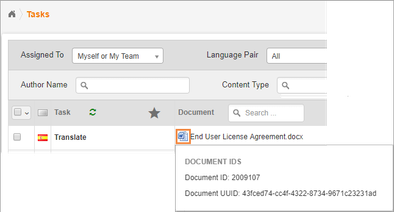 Image Removed
Image Removed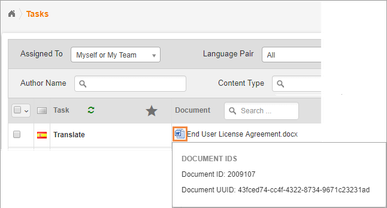 Image Added
Image AddedOpen a task
Click the More symbol in the second to the right column of the applicable row to begin working on a task.

When the options appear, select any of the following:
Launch Workbench. Select Launch Workbench to open the Workbench application and then begin translating files. This option is ideal for files with few formatting complexities.
Launch Doc Viewer. Select Launch Doc Viewer to open the Document Viewer and then quickly scan and check multiple segments at once. This option is ideal for file reviewers.
Upload Finalized File. Select Upload Finalized File to upload the final version of the translated file. This option is ideal for DTP.
Check in and check out tasks
Tasks can be assigned to individual linguists or to translating teams.
If you are a linguist, you can assign a task to yourself by checking out the task. It’s important to check out the task to reserve it for you, thus making sure that the task doesn’t appear in other linguist’s pipeline.
To check out a task, click the More symbol in the second column from the right. When the options appear, select Check Out.
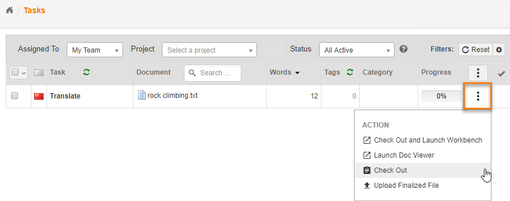
If a task is left uncompleted, linguists can check back in a task to continue working on it. To check in a task, click the More symbol in the second column from the right. When the options appear, select Check In.
Other functionalities in Tasks
The following are other functionalities that users can use in the Tasks feature. To access these options, click the More symbol in the second column from the right.
If these options don’t appear on your end, contact your team’s project manager to be granted access to them.
Action | Function |
|---|---|
Select this option to submit a completed translation task. | |
Set Task Progress % | Select this option to manually record the progress of your tasks. This option is designed for engineering and DTP phases. |
Source URL | Select this option to view the source document of a task. For example, when a linguist is translating web content, the project manager provides the source URL of the task. When this option is selected, a linguist can view the original source document or page. You can also add the Launch Source URL column to the Tasks page to access the source URL faster. |
TM Statistics | Select this option to view translation memory (TM) statistics. By viewing the available statistic, users can gauge how much of the document is leveraged from TM. Here’s an example of TM statistics. 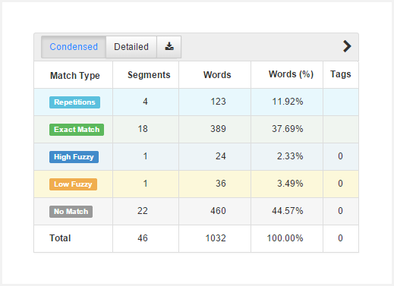 Image Removed Image Removed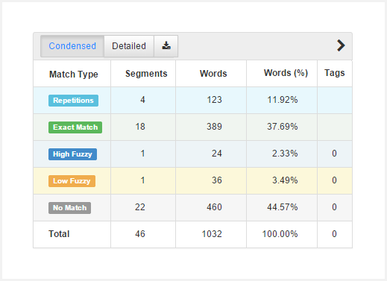 Image Added Image Added |
Check-out History | Select this option to view the check in and check out history of a task. 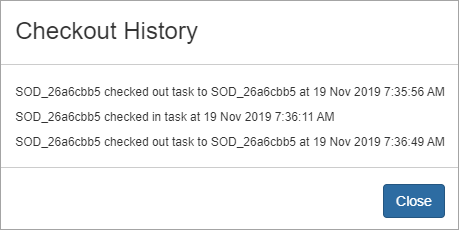 |
| Select this option to download the source files of a task. Depending on the features that a project manager assigned to a community member, this option appears both in the Tasks feature and the Workbench application. Users can download sources documents in several file formats such as PDF, TMX, and XLIF. |
| Select this option to download the target files of a task. Depending on the features that a project manager assigned to a community member, this option appears both in the Tasks feature and the Workbench application. Users can download the target documents in several file formats such as PDF, TMX, and XLIF. |
On this page:
| Table of Contents |
|---|
Related pages:
| Child pages (Children Display) |
|---|